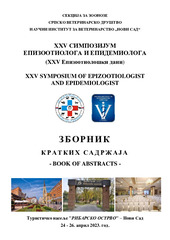Приказ основних података о документу
Visok nivo rezistencije na fluorohinolone komensalnih Escherichia coli izolovanih o divljih životinja i ptica u Srbiji
High level of resistance to fluoroquinolones in commensal Escherichia coli isolated from wild animals and birds in Serbia
| dc.creator | Todorović, Dalibor | |
| dc.creator | Kozoderović, Gordana | |
| dc.creator | Pajić, Marko | |
| dc.creator | Đurđević, Biljana | |
| dc.creator | Ljubojević Pelić, Dragana | |
| dc.creator | Marjanović, Đorđe | |
| dc.creator | Velhner, Maja | |
| dc.date.accessioned | 2023-11-14T12:25:08Z | |
| dc.date.available | 2023-11-14T12:25:08Z | |
| dc.date.issued | 2023 | |
| dc.identifier.isbn | 978-86-83115-48-8 | |
| dc.identifier.uri | https://vet-erinar.vet.bg.ac.rs/handle/123456789/3347 | |
| dc.description.abstract | Коменсалне E. coli у цревима дивљих животиња нису изложене честим директним антимикробним притисцима, као што је случај са коменсалним E. coli у цревима домаћих, посебно фармских животиња и кућних љубимаца. Резистенција ових бактерија код дивљих животиња настала је индиректно, односно човековим немаром и загађењем животне средине, чиме су бактерије отпорне на антибиотике доспеле у ланац исхране дивљих животиња. Као последица тога, у бактеријској цревној флори дивљих животиња и птица, ипак постоји селективни притисак, који је одговоран за перзистенцију гена резистенције. У овом раду су приказани резултати истраживања резистенције индикаторске E. coli на флуорохинолоне, које је у последњих пет година спровела Национална референтна лабораторија за антимикорбну резистенцију у ветеринарској медицини у Србији. Детектован је висок ниво резистенције на флуорохинолоне коменсалне E. coli код дивљих свиња, зечева, срна и јелена у ловиштима на територији Аутономне покрајине Војводине. Oве бактерије су поред хромозомске резистенције имале и плазмидски преносиву резистенцију на флуорохинолоне (PMQR). Резистенција на флуорохинолоне је откривена и код коменсалне E. coli од орлова белорепана у Специјалном резревату природе „Горње Подунавље“, делу резервата биосфере „Бачко Подунавље“, које се налази на УНЕСКО-вој светској листи резервата биосфере. Такође, резистенција коменсалне E. coli на флуорохинолоне је детектована и код црноглавих галебова који се хране на депонији града Новог Сада. Забрињавајући је висок ниво резистенције на синтетске антибиотике, тј. на флуорохинолне у популацији дивљих животиња и птица јер ови антибиотици често представљају лек избора у терапији одређених бактеријских инфекција људи и домаћих животиња. Дивље животиње и птице су потенцијални резервоари гена резистенције и могу бити одговорне за ширење резистенције у бактеријским заједницама на нашој планети. | sr |
| dc.description.abstract | Commensal E. coli in the intestines of wild animals are not exposed to frequent direct antimicrobial pressure, as is the case with commensal E. coli in the intestines of domestic, especially farm animals and pets. The resistance of these bacteria in wild animals was caused indirectly, that is, by human negligence and environmental pollution, which allowed antibiotic-resistant bacteria to enter the food chain of wild animals and birds. Consequently, in the bacterial intestinal flora of wild animals and birds, there is nevertheless a selective pressure, which is responsible for the persistence of resistance genes. This paper presents the results of the research on the resistance of indicator E. coli to fluoroquinolones, which was conducted in the last five years by the National Reference Laboratory for Antimicrobial Resistance in Veterinary Medicine in Serbia. A high level of resistance to fluoroquinolones of commensal E. coli was detected in wild boars, rabbits, roe deer and deer in hunting grounds on the territory of the Province of Vojvodina. In addition to chromosomal resistance, these bacteria also had plasmid-mediated resistance to fluoroquinolones (PMQR). Resistance to fluoroquinolones was also discovered in commensal E. coli from white-tailed eagles in the Gornje Podunavlje Special Natural Reserve, a part of Bačko Podunavlje Biosphere Reserve, approved as a UNESCO Biosphere Reserve. Also, resistance to fluoroquinolones of commensal E. coli was detected in Blackheaded gulls that feeding at the landfill of the city of Novi Sad. Very worrying the high level of resistance to synthetic antibiotics, ie. to fluoroquinolone in the population of wild animals and birds because these antibiotics are often the drug of choice in the treatment of certain bacterial infections of humans and domestic animals. Wild animals and birds are potential reservoirs of resistance genes and may be responsible for dissemination of resistance in bacterial communities on our planet. | sr |
| dc.language.iso | sr | sr |
| dc.language.iso | en | sr |
| dc.publisher | Beograd : Srpsko veterinarsko društvo, Sekcija za zoonoze | sr |
| dc.relation | info:eu-repo/grantAgreement/MESTD/inst-2020/200031/RS// | sr |
| dc.rights | openAccess | sr |
| dc.rights.uri | https://creativecommons.org/licenses/by/4.0/ | |
| dc.source | XXV Simpozijum epizootiologa i epidemiologa (XXV Epizootiološki dani), Novi Sad, 24 - 26. april 2023 | sr |
| dc.subject | коменсална E | sr |
| dc.subject | coli | sr |
| dc.subject | резистенција | sr |
| dc.subject | флуорохинолони | sr |
| dc.subject | дивље животиње | sr |
| dc.subject | птице | sr |
| dc.subject | commensal E | sr |
| dc.subject | coli | sr |
| dc.subject | resistance | sr |
| dc.subject | fluoroquinolones | sr |
| dc.subject | wild animals | sr |
| dc.subject | birds | sr |
| dc.title | Visok nivo rezistencije na fluorohinolone komensalnih Escherichia coli izolovanih o divljih životinja i ptica u Srbiji | sr |
| dc.title | High level of resistance to fluoroquinolones in commensal Escherichia coli isolated from wild animals and birds in Serbia | sr |
| dc.type | conferenceObject | sr |
| dc.rights.license | BY | sr |
| dc.citation.spage | 182 | |
| dc.citation.epage | 183 | |
| dc.description.other | Zbornik kratkih sadržaja | sr |
| dc.identifier.fulltext | http://veterinar.vet.bg.ac.rs/bitstream/id/9956/bitstream_9956.pdf | |
| dc.identifier.rcub | https://hdl.handle.net/21.15107/rcub_veterinar_3347 | |
| dc.type.version | publishedVersion | sr |

